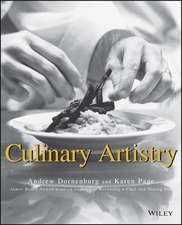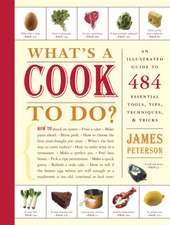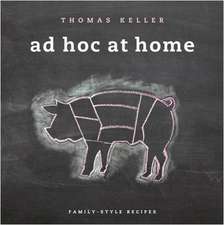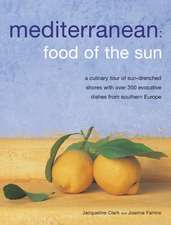Martha Stewart's Cooking School
Autor Martha Stewart Fotografii de Marcus Nilssonen Limba Engleză Hardback – 30 sep 2008
Vezi toate premiile Carte premiată
Imagine having Martha Stewart at your side in the kitchen, teaching you how to hold a chef’s knife, select the very best ingredients, truss a chicken, make a perfect pot roast, prepare every vegetable, bake a flawless pie crust, and much more.
In Martha Stewart’s Cooking School, you get just that: a culinary master class from Martha herself, with lessons for home cooks of all levels.
Never before has Martha written a book quite like this one. Arranged by cooking technique, it’s aimed at teaching you how to cook, not simply what to cook. Delve in and soon you’ll be roasting, broiling, braising, stewing, sautéing, steaming, and poaching with confidence and competence. In addition to the techniques, you’ll find more than 200 sumptuous, all-new recipes that put the lessons to work, along with invaluable step-by-step photographs to take the guesswork out of cooking. You’ll also gain valuable insight into equipment, ingredients, and every other aspect of the kitchen to round out your culinary education.
Featuring more than 500 gorgeous color photographs, Martha Stewart’s Cooking School is the new gold standard for everyone who truly wants to know his or her way around the kitchen.
Preț: 296.15 lei
Nou
Puncte Express: 444
Preț estimativ în valută:
56.67€ • 59.59$ • 46.82£
56.67€ • 59.59$ • 46.82£
Carte disponibilă
Livrare economică 26 martie-09 aprilie
Livrare express 12-18 martie pentru 102.12 lei
Preluare comenzi: 021 569.72.76
Specificații
ISBN-13: 9780307396440
ISBN-10: 0307396444
Pagini: 512
Ilustrații: full-color photographs
Dimensiuni: 206 x 264 x 42 mm
Greutate: 1.99 kg
Editura: Clarkson N Potter Publishers
Locul publicării:New York, NY
ISBN-10: 0307396444
Pagini: 512
Ilustrații: full-color photographs
Dimensiuni: 206 x 264 x 42 mm
Greutate: 1.99 kg
Editura: Clarkson N Potter Publishers
Locul publicării:New York, NY
Notă biografică
MARTHA STEWART is the author of dozens of bestselling books on cooking, entertaining, gardening, weddings, and decorating. She is the host of The Martha Stewart Show, the Emmy-winning, daily national syndicated program, and founder of Martha Stewart Living Omnimedia, which publishes several magazines, including Martha Stewart Living; produces Martha Stewart Living Radio, channel 112 on SIRIUS Satellite Radio; and provides a wealth of ideas and information on www.marthastewart.com.
SARAH CAREY graduated from the Culinary Institute of America. In 1999, she joined MSLO, where she is food editor of Martha Stewart Living and a regular contributor to Everyday Food magazine. She is also one of the hosts of the PBS television show Everyday Food.
SARAH CAREY graduated from the Culinary Institute of America. In 1999, she joined MSLO, where she is food editor of Martha Stewart Living and a regular contributor to Everyday Food magazine. She is also one of the hosts of the PBS television show Everyday Food.
Extras
Prime Rib Roast
Serves 8
Prime rib, or standing rib roast, has long been a mainstay at the holiday table (where it is often paired with Yorkshire pudding, a British specialty made from the pan juices and a simple batter of flour, eggs, and milk). As it is expensive, prime rib should be handled with extra care. It is imperative that you have an instant-read thermometer for determining the internal temperature; if allowed to cook too long, the meat will no longer be a rosy pink inside, the optimal color for any high-quality roast. Remove the roast when still rare, as it will continue to cook as it rests, rising as much as 10 degrees in 20 minutes.
Rubbing meat (as well as chicken and fish) with herbs, spices, and a bit of oil will add tremendous flavor. Here, the beef is coated with a mixture of bay leaves, sage, and orange zest, all familiar holiday flavors. Allowing the meat to “marinate” in the rub overnight deepens the flavor even more. A similar result is achieved by simply salting the meat a day or two before roasting, whereby the salt will have penetrated the meat much like a brining solution.
Larger roasts such as prime rib, crown roast, and a whole turkey are started at a high temperature (450°F) to sear the meat, then the temperature is lowered after 30 minutes to prevent the outside from burning before the meat is cooked through. The exterior won’t develop a crust right away, but the initial high heat gives the outside a head start so that it will be perfectly browned in the end.
For Rub
• 15dried bay leaves, crumbled
• 1/3 cup coarsely chopped fresh sage leaves, plus several whole leaves for garnish
• 1/2 cup extra-virgin olive oil
• Coarse salt and freshly ground pepper
• 1/3 cup finely grated orange zest (from 2 to 3 oranges)
For Roast
• 1 three-rib prime rib of beef (about 7 pounds), trimmed and frenched
Prepare meat: Stir together crumbled bay leaves, sage, the oil, 1½ teaspoons salt, and the orange zest in a small bowl. Season with pepper. Rub herb mixture all over the beef, coating evenly. Refrigerate overnight, covered. About 2 hours before you plan to cook the beef, remove it from the refrigerator. Place beef, fat side up, in a roasting pan and allow it to come to room temperature. Meanwhile, heat the oven to 450°F.
Roast: Cook beef for 30 minutes, then reduce temperature to 350°F and continue roasting until an instant-read thermometer inserted into meat (away from bone) registers 115°F to 120°F (for rare), about 1 hour to 1 hour 15 minutes longer. Let rest 20 minutes.
Carve and serve Slice meat away from ribs, cutting along the bones. Then, slice meat crosswise to desired thickness. Serve, garnished with whole sage leaves.
Serves 8
Prime rib, or standing rib roast, has long been a mainstay at the holiday table (where it is often paired with Yorkshire pudding, a British specialty made from the pan juices and a simple batter of flour, eggs, and milk). As it is expensive, prime rib should be handled with extra care. It is imperative that you have an instant-read thermometer for determining the internal temperature; if allowed to cook too long, the meat will no longer be a rosy pink inside, the optimal color for any high-quality roast. Remove the roast when still rare, as it will continue to cook as it rests, rising as much as 10 degrees in 20 minutes.
Rubbing meat (as well as chicken and fish) with herbs, spices, and a bit of oil will add tremendous flavor. Here, the beef is coated with a mixture of bay leaves, sage, and orange zest, all familiar holiday flavors. Allowing the meat to “marinate” in the rub overnight deepens the flavor even more. A similar result is achieved by simply salting the meat a day or two before roasting, whereby the salt will have penetrated the meat much like a brining solution.
Larger roasts such as prime rib, crown roast, and a whole turkey are started at a high temperature (450°F) to sear the meat, then the temperature is lowered after 30 minutes to prevent the outside from burning before the meat is cooked through. The exterior won’t develop a crust right away, but the initial high heat gives the outside a head start so that it will be perfectly browned in the end.
For Rub
• 15dried bay leaves, crumbled
• 1/3 cup coarsely chopped fresh sage leaves, plus several whole leaves for garnish
• 1/2 cup extra-virgin olive oil
• Coarse salt and freshly ground pepper
• 1/3 cup finely grated orange zest (from 2 to 3 oranges)
For Roast
• 1 three-rib prime rib of beef (about 7 pounds), trimmed and frenched
Prepare meat: Stir together crumbled bay leaves, sage, the oil, 1½ teaspoons salt, and the orange zest in a small bowl. Season with pepper. Rub herb mixture all over the beef, coating evenly. Refrigerate overnight, covered. About 2 hours before you plan to cook the beef, remove it from the refrigerator. Place beef, fat side up, in a roasting pan and allow it to come to room temperature. Meanwhile, heat the oven to 450°F.
Roast: Cook beef for 30 minutes, then reduce temperature to 350°F and continue roasting until an instant-read thermometer inserted into meat (away from bone) registers 115°F to 120°F (for rare), about 1 hour to 1 hour 15 minutes longer. Let rest 20 minutes.
Carve and serve Slice meat away from ribs, cutting along the bones. Then, slice meat crosswise to desired thickness. Serve, garnished with whole sage leaves.
Descriere
Arranged by technique, this resource is designed to teach someone how to cook, not simply what to cook. Thoroughly covering cooking methods, the text also includes 200 sumptuous new recipes that put the lessons to work.
Premii
- James Beard Foundation Book Awards Nominee, 2009













